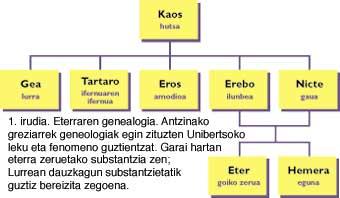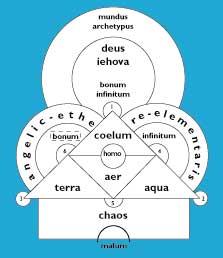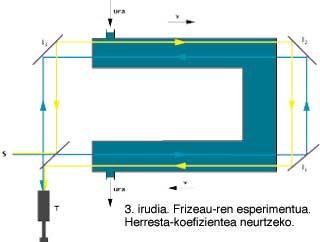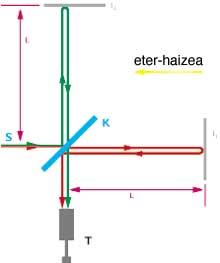Ether and amilera boom
Today ether is nothing more than a simple chemical compound, but throughout the history of Physics there has always been a wonderful substance called ether: Who began to be God and ended up with nothing.
The word ether comes from the Greek. In fact, eter <unk> xliff-newline{\} in Greek is written{\}, and its root is <unk> xliff-newline{\} (in flames). It is a fairly direct origin, as we will see later, as it has historically been related to fire and light.
God
Nine centuries before the birth of Jesus Christ, the ether was the higher heaven, where all the bodies we know in heaven live. While philosophy was about to appear, the explanation and description of the world depended on poets.
One of them, the Greek Hesiod, tells us the birth of all gods. VIII. In his book Teogonia of the twentieth century. Since many gods were parts and phenomena of the universe, theogony becomes cosmogony. Thus our ether becomes Ether and finds a family: According to Hesiod, he is the son of Eter Nicte (Gaua) and Erebo (Ilunbe), and Hemera (Eguna) (see figure 1).
But as in the poems everyone can say what they want, it should not surprise us that not everyone agrees. For example, the Greek Higinius tells us that he is the son of Eter Kaos and Kaligo, the husband of Hemera, and the father of Zeru, Itsaso, Lur, etc.
However, the Roman cicero considers him the father of Jupiter and Cælus, etc.

Burning Air
Leaving aside possible relatives of ether, we know Homer for the first time. C. IX. In the twentieth century he mentioned it. The ether, according to him, was the fire under the kneading, the upper atmosphere or the celestial light. In other words, the air surrounding stars, planets, sun and moon.
For those ancient Greeks, as water has filled the sea and the air has occupied the space in which we live, the skies were filled with ether. From this point of view, questioning the existence of ether was like questioning the existence of water.
After recognizing their existence, the first philosophers began to explain the nature of ether. According to Enpedokles (a. C. V. m.) were four basic elements or essences: earth, water, air and fire. All things of the world were formed by a mixture of the four essences mentioned. The different proportions of the four essences showed differences between bodies or materials. The ether was therefore a mixture of air and fire.
Something later, a. C. IV. In the 20th century, both meaning and character underwent a major change from the hand of Aristotle.
Fifth essence
Aristotle divided the world into two spheres: the parts of the moon and the moon. The first, changeable, corrupt, of direct movement and built with earth, water, air and fire. In the sphere of the moon, however, there were no changes, no corruption, it had a circular motion and, as we know, it was a milestone.

Being both worlds so different, it was impossible that they were made with the same ingredients. The ether could not be a mixture of air and fire. She herself had to be the fundamental essence: the fifth essence. Moreover, to meet the needs of the lunar world (eternity, perfection...), this fifth essence (ether) was better than the other four. Hence the alchemists took the idea of quintessence.
The ether with Aristotle is, on the one hand, the raw material of the sky, but, at the same time, also the celestial light that comes from the hour of seeing the objects.
Ether, in short, surrounds all common matter, but is not made of ordinary essences, as it is the fifth essence.
Mysticism
All that Aristotle said was taken as a model until the end of the Middle Ages and, moreover, Christianity made thought impregnated with mysticism. Dear Beda (VIII. m.), for example, saw seven heavens on Earth: the air, the ether, the Olympus, the walnut sky, the stars, the angels and the Holy Trinity.
As we see, the ether was always there. Also in alchemist models, as can be seen in Figure 2.
Vacuum filler
At the end of the Middle Ages, respect for Aristotle was lost and his ideas were abandoned. However, the ether remained healthy, although it changed in need.
From practically the beginning the ether has been linked to the idea of emptiness, but the history of emptiness would require the whole article. Therefore, we will not delve into it. Derragun Descartes (XVII. m.) seemingly empty and ether saturated spaces. According to this philosopher the ether did not weigh and was the origin of the movement.
In addition, he explained the different weight of the bodies of the same volume: the one that weighed the least had more ether and vice versa.
Absolute space
The Dutch Huygens (XVII. m.) defended the dispersion of light in the form of a wave. But the waves need some support for their diffusion. Sound, for example, needs air, water, or something else to move. But the light of the stars reaches us through empty space. What could be the support of light? Huygens believes that there should be a thin, elastic substance that occupied the entire space: the ethers.
Newton (XVII. m.) also needed ether. Newton did not admit that light was the wave. According to him, it was made up of fractions. However, his gravitational theory worried him: how were two bodies known far away? How did they feel attracted? Some support was needed to carry the information, which was ether.
The ether of Huygens and Newton was not a god, nor like that of Aristotle, because it was not the raw material of the stars. But still the ether was wonderful: the translucent, frictionless, static, immutable, and both stars and planets could move inside without obstacles.
Therefore, XIX. At the end of the century, all scientists recognized ether. Besides being extremely agile and flexible, it occupied the entire space. It was also an absolute space: that environment or support called ether, which covered everything, was an absolute reference for all the bodies of the universe.

End of ether
The twenty-eight centuries of the celestial history of the ether were over by trying to prove it experimentally.
Danish astronomers Römer (XVII. m.) proposed a measure of Earth's speed over ether. But at that time the technology was not as good as carrying out the experience.
XIX. In the 20th century, however, the characteristics of ether were not so clear. On the one hand, Maxwell's electromagnetic theory of light (1861) guaranteed the existence of ether, but on the other hand, some optical observations attributed different characteristics to it. French Fresnel saw in 1818 that the Earth was paralyzed with ether. This meant that the Earth dragged the ether.
Fizeau demonstrated in 1851 the existence of drag coefficients (see figure 3).

But the total test would come in 1887 with the prestigious experiment conducted by American physicists Michelson and Morley. It was intended to detect the movement of the Earth with respect to ether, absolute space. The reasoning of the experiment was based on: 1) the velocities of the luminous waves were relative to the support (ether); 2) the Earth moves through the ether. Therefore, ether wind occurs in the opposite direction of motion; 3) the movement of light in the direction of wind or in other directions will influence the speed of observed light.
The essence of the experiment is indicated in Figure 4: we have two swimmers, the first swimming in the direction of the current and the second perpendicular. If there were any current, the second would arrive before the goal.

The experiment is represented in Figure 5. Input of the interferometer into a container full of mercury. In this device a beam of light leaves S towards K. Upon reaching the K glass, the light beam is divided into two parts, one towards the I1 mirror and one towards the I2. They reflect in mirrors and return to K. In glass K, the one from M2 continues straight to T, while the one from I1 reaches T once reflected in glass K.
The two rays must travel the same distance, but if there is etheric wind, one of them must arrive before the other to the T telescope. The result of the experiment, however, was total: There was no wind of ether and therefore there was no movement of the Earth from the ether. In addition, the emergence of ether on Earth generated an even more complicated problem. Eterra was about to die.
When Einstein published in 1905 the Theory of Special Relativity, the story of the wonderful ether ended. There was no ether.





